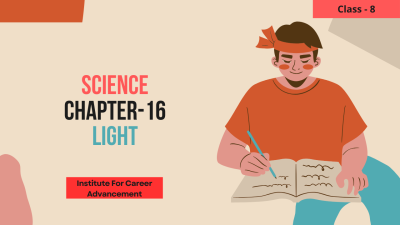| Outcomes |
- Here are the expected course outcomes for students studying light at this level: Knowledge and Understanding: Understanding the Nature of Light: Students should grasp the concept of light as a form of energy that travels in straight lines and can be reflected, refracted, and dispersed. Properties of Light: They should be familiar with the properties of light, including reflection, refraction, dispersion, and absorption, and be able to explain these phenomena using appropriate examples. Sources of Light: Students should differentiate between natural and artificial sources of light, understanding their significance and everyday applications. Optics: Gain basic knowledge of optics, including how mirrors and lenses work, and their applications in everyday devices such as telescopes, microscopes, and cameras. Colors and Vision: Understand how colors are produced by light and perceived by the human eye, including the basics of the visible spectrum and the role of light in vision. Skills Development: Experimental Skills: Develop skills in conducting simple experiments to observe and demonstrate the behavior of light, such as using mirrors and lenses to show reflection and refraction. Problem-Solving Skills: Apply knowledge of light to solve problems related to optics and everyday situations where understanding light behavior is crucial. Practical Applications: Technological Understanding: Recognize the practical applications of light in various technologies, such as communication systems using fiber optics, medical instruments using lasers, and the function of optical lenses in cameras. Critical Thinking: Engage in critical thinking about how light influences everyday life, technology, and scientific discoveries. Conceptual Integration: Integration with Other Sciences: Understand how concepts related to light integrate with other scientific disciplines, such as biology (vision), chemistry (light absorption and emission), and earth sciences (Sunlight and its effects).
- এই স্তরে হালকা অধ্যয়নরত শিক্ষার্থীদের জন্য এখানে প্রত্যাশিত কোর্সের ফলাফল রয়েছেঃ জ্ঞান এবং বোধগম্যতাঃ আলোর প্রকৃতি বোঝাঃ শিক্ষার্থীদের আলোর ধারণাকে শক্তির একটি রূপ হিসাবে উপলব্ধি করা উচিত যা সরলরেখায় ভ্রমণ করে এবং প্রতিফলিত, প্রতিসরণ এবং ছড়িয়ে পড়তে পারে। আলোর বৈশিষ্ট্যঃ তাদের প্রতিফলন, প্রতিসরণ, বিচ্ছুরণ এবং শোষণ সহ আলোর বৈশিষ্ট্যগুলির সাথে পরিচিত হওয়া উচিত এবং উপযুক্ত উদাহরণ ব্যবহার করে এই ঘটনাগুলি ব্যাখ্যা করতে সক্ষম হওয়া উচিত। আলোর উৎসঃ শিক্ষার্থীদের আলোর প্রাকৃতিক এবং কৃত্রিম উৎসের মধ্যে পার্থক্য করতে হবে, তাদের তাৎপর্য এবং দৈনন্দিন প্রয়োগগুলি বুঝতে হবে। আলোকবিজ্ঞানঃ আয়না এবং লেন্স কীভাবে কাজ করে এবং টেলিস্কোপ, মাইক্রোস্কোপ এবং ক্যামেরার মতো দৈনন্দিন ডিভাইসে তাদের প্রয়োগ সহ আলোকবিজ্ঞানের প্রাথমিক জ্ঞান অর্জন করুন। রঙ এবং দৃষ্টিঃ দৃশ্যমান বর্ণালীর মূল বিষয়গুলি এবং দৃষ্টিতে আলোর ভূমিকা সহ কীভাবে রঙগুলি আলো দ্বারা উত্পাদিত হয় এবং মানুষের চোখ দ্বারা অনুভূত হয় তা বুঝুন। দক্ষতা বিকাশঃ পরীক্ষামূলক দক্ষতাঃ আলোর আচরণ পর্যবেক্ষণ এবং প্রদর্শনের জন্য সহজ পরীক্ষা-নিরীক্ষা পরিচালনার দক্ষতা বিকাশ করুন, যেমন প্রতিফলন এবং প্রতিসরণ দেখানোর জন্য আয়না এবং লেন্স ব্যবহার করা। সমস্যা সমাধানের দক্ষতাঃ আলোকবিদ্যা এবং দৈনন্দিন পরিস্থিতি সম্পর্কিত সমস্যা সমাধানের জন্য আলোর জ্ঞান প্রয়োগ করুন যেখানে আলোর আচরণ বোঝা অত্যন্ত গুরুত্বপূর্ণ। ব্যবহারিক প্রয়োগঃ প্রযুক্তিগত বোধগম্যতাঃ বিভিন্ন প্রযুক্তিতে আলোর ব্যবহারিক প্রয়োগকে স্বীকৃতি দিন, যেমন ফাইবার অপটিক্স ব্যবহার করে যোগাযোগ ব্যবস্থা, লেজার ব্যবহার করে চিকিৎসা যন্ত্র এবং ক্যামেরায় অপটিক্যাল লেন্সের কার্যকারিতা। সমালোচনামূলক চিন্তাভাবনাঃ আলো কীভাবে দৈনন্দিন জীবন, প্রযুক্তি এবং বৈজ্ঞানিক আবিষ্কারগুলিকে প্রভাবিত করে সে সম্পর্কে সমালোচনামূলক চিন্তায় জড়িত হন। ধারণাগত সংহতকরণঃ অন্যান্য বিজ্ঞানের সাথে সংহতকরণঃ আলোর সাথে সম্পর্কিত ধারণাগুলি কীভাবে অন্যান্য বৈজ্ঞানিক শাখার সাথে একীভূত হয় তা বুঝুন, যেমন জীববিজ্ঞান (দৃষ্টি) রসায়ন (আলো শোষণ এবং নির্গমন) এবং পৃথিবী বিজ্ঞান (Sunlight and its effects).
|
|
|
| Requirements |
- Light is a fundamental aspect of the natural world. Studying it helps students understand how light behaves, from reflection off surfaces to the bending of light through different materials (refraction). This understanding forms the basis for explaining a wide range of natural phenomena, from rainbows to the behavior of lenses. The study of light includes understanding how we see and perceive colors. This knowledge helps students appreciate how the eye works as an optical instrument and how light influences our perception of the world around us. In summary, studying light in Class 8 provides essential knowledge and skills that are not only valuable for understanding the natural world but also for preparing students for future academic and professional pursuits in a wide range of fields.
- আলো প্রাকৃতিক জগতের একটি মৌলিক দিক। এটি অধ্যয়ন শিক্ষার্থীদের বুঝতে সাহায্য করে যে আলো কীভাবে আচরণ করে, পৃষ্ঠের প্রতিফলন থেকে শুরু করে বিভিন্ন উপকরণের মাধ্যমে আলোর বাঁকানো পর্যন্ত। (refraction). এই বোধগম্যতা রামধনু থেকে লেন্সের আচরণ পর্যন্ত বিভিন্ন ধরনের প্রাকৃতিক ঘটনা ব্যাখ্যা করার ভিত্তি তৈরি করে। আলোর অধ্যয়নের মধ্যে রয়েছে আমরা কীভাবে রঙ দেখি এবং উপলব্ধি করি তা বোঝা। এই জ্ঞান শিক্ষার্থীদের বুঝতে সাহায্য করে যে কীভাবে চোখ একটি আলোকীয় যন্ত্র হিসাবে কাজ করে এবং কীভাবে আলো আমাদের চারপাশের বিশ্ব সম্পর্কে আমাদের উপলব্ধি প্রভাবিত করে। সংক্ষেপে, অষ্টম শ্রেণিতে হালকা অধ্যয়ন প্রয়োজনীয় জ্ঞান এবং দক্ষতা সরবরাহ করে যা কেবল প্রাকৃতিক বিশ্বকে বোঝার জন্যই নয়, ভবিষ্যতের একাডেমিক এবং পেশাদার অনুধাবনের জন্য শিক্ষার্থীদের বিস্তৃত ক্ষেত্রে প্রস্তুত করার জন্যও মূল্যবান।
|
|
|


 0
0 